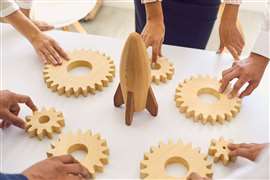Clear vision?
22 April 2008
Aichi Corp has been generating a lot of press attention without saying very much, but now the company’s senior managers, including chief executive officer Shinji Takeuchi, have finally ventured into public to give some information on the company’s new ‘global vision’, and to show off its new global products.
As you would expect, Mr Takeuchi has set the company a big target: to become market leader in the aerial work platform. “Our target is global number one”, he says to Access International at a special launch event in February held at one of Aichi’s two facilities in Oosterhout, the Netherlands, “This means a marker share of around 30%.” Aichi currently claims a global share of closer to 10%.
Speaking in Japanese - his answers translated by Aichi’s long-time export specialist Ken Nezuka –Mr Takeuchi says the aim is to grow its share by 2-3% every year. The prime mover behind the growth will be a new range of global products, the first of which - 12 and 14 m telescopic booms and 6 and 8 m electric scissors – were shown at Oosterhout in early February. These new machines will complement Aichi’s existing, and highly regarded, crawler telescopic machines.
The notably compact booms and long-duty cycle scissors (see box stories) are the first of what will be a much wider range. Aichi is still unwilling to give details, but AI understands that 12, 16 and 18 m articulated booms and 30 and 32 m telescopic self-propelled models, as well as rough terrain scissors, will follow over the next year or two.
Mr Takeuchi is clear that in chasing market share, Aichi will not abandon its premium-brand standing: quality will remain a hallmark of the company’s products, he says. However, he does say that Aichi is prepared to be more aggressive on pricing than in the past, and it does seem that in Europe so far Aichi has managed to set competitive pricing on the new machines: competitive enough to get some major orders, not least the previously announced 600 unit order from Doornbos Equipment in the Netherlands.The price issue will be even more important with the electric scissors, a ‘commodity’ product that is difficult to differentiate from the competition. Aichi is trying, of course, saying that the use of the AC drive technology (a system used on the forklift trucks made by Toyota, Aichi’s parent company) will help. However, it remains to be seen if buyers are tempted by the technology to pay what could well be a premium price.
If Aichi’s precise strategy on pricing is still to be disclosed, it is also unforthcoming on its manufacturing plans. Earlier reports – based on statements from Aichi in the US – that it was planning to manufacture in the US at an existing Toyota facility, seem to be wide of the mark. “Now we are in the process of carrying out a feasibility study. We haven’t decided where to manufacture first”, says Mr Takeuchi, adding that a US facility is “not in our plans at the moment”. He says the US downturn has not led to a change of heart. There is no mistaking Aichi’s goal to increase dramatically its export sales. It has remarkable market shares in its domestic aerials market – claiming 78% in the power utility sector, 76% in telecom lifts, and 65% in construction/rental machines – but these impressive figures will surely come under increasing threat as the big western manufacturers gear up their operations in Asia. Genie, for example, is already talking about having an Asian production facility. Mr Takeuchi says Aichi is always aware of its competitors but believes it can hold on to its dominant home position. The context for Aichi’s global push is also important: its domestic aerials market is flat, says Mr Takeuchi – following five years in which Japanese rental companies have been replacing their fleets – and it has a parent company, Toyota Industries, that has already transformed Aichi since it took control five years ago. Mr Takeuchi says Toyota’s lean production techniques have doubled production capacity at the production line that was operating at the main plant when Toyota took over. A further two lines have been established since. He says that under Toyota’s ownership, revenues have risen from US$335 million in 2002 to over $750 million anticipated for the current 2007 fiscal year. Perhaps more importantly, profit before tax has risen from zero to $135 million over the same period. Access International asks if there are any surprises being prepared? For instance, in 2002 it acquired an access rental company in Japan, Rentec, that now has a fleet of around 1000 machines and revenues of $40 million. Would it consider a move into access rental in any other markets? The answer is no: “The Japanese rental company gives us good information on the products, and we think it is sufficient”, says Mr Takeuchi. He dismisses the prospects of a Chinese rental business. What about a move into telehandlers? The global vision is for aerial work platforms, reiterates Mr Takeuchi, and any move to produce handlers is another item that is low down on the priority list. Never mind telehandlers, what Aichi’s customers will want is more of the new ‘global’ products. The first ones have just arrived; try to be patient if you’re waiting for more.



